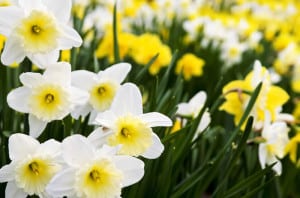Here, once again, courtesy of the lovely folks at Sloat Nursery, is your to-do list for the garden. Except, this year in our gardens everything seems to be happening about a month early! Roses are leafed out; one at Deanna's is already blooming. Grape vines have uncurled tight fists of leaves. Daffodils are, for the most part, over. The buckeye, always precocious, has thrown a dense green roof over the round gravel patio, and covered the big bathroom window. When I brush my teeth in the morning it's like being under water, cool and deep green.
Dogwood buds have gone from tight grey pincushions to thick and wavy and yellow, like little flags. They usually bloom in April; this year I don't think they'll last thru March.
Of course, if you live in the Frozen East, this list will probably just piss you off. Get out your snow shovel and get over it. Or come visit - we'll be on the patio. In our shirtsleeves.
What To Do In The Garden Now:
• Prepare planting beds for spring. Test your soil for pH, nitrogen, phosphorous and potassium and add the appropriate fertilizer or supplement. We recommend amending your soil with Sloat Loam Builder, Sloat Forest Mulch Plus or Sloat Planting Mix. Also, add E.B Stone’s Agricultural Lime or Grow More Maxi-Cal to soil to provide needed calcium for vegetables & fruit and to prevent blossom end rot.
• Plant early blooming plants like peonies, wisteria, lilacs, flowering plum, cherries, and magnolia. You can also plant Mediterranean plants such as leucadendrons, lavender, rosemary. Ceanothus and manzanita are great California Native choices.
• Protect your plants from slugs and snails with Sluggo or Sluggo Plus.
• Now is the time to plant edibles: Potatoes, garlic, onions, rhubarb, and asparagus.
• Finish pruning roses, shrubs and trees. Need a little guidance? Check out a pruning seminar at our stores.
• Prune and cut back perennials & ornamental grasses.
• Stop the weeds! Weeds that begin with winter rains go to seed in March & April. But the clever gardener never lets them get that far. Pull weeds now before they go to seed.
• After pruning, feed roses with E.B. Stone Alfalfa Meal and E.B. Stone Naturals Sul-Po-Magto promote healthy cane growth.
• Prune lavender back to emerging new growth for best spike production this coming summer.
• In addition to preparing your planting beds, use winter aged compost to make room for your new trimmings and clippings.
• It’s time to think about starting seeds. Most seeds are started 6-8 weeks prior to the last frost.
• Add summer flowering gladiolas and dahlias to your garden.
• During the month of February we have the best citrus selection of the year. Stop in!
• Protect citrus from rodents with Repels All Ready to Use.
• Now is a good time to feed and repot houseplants in anticipation of spring growth. Check for insects.
• Deadhead cyclamen to keep them in bloom.
• After pruning, be sure to clean your tools.
• Feed the birds: We carry Wild Delight Gourmet Bird Seed, Songbird Blend, Nut & Berry, Nyjer thistle, and Sunflower Seed. Also we have suet in 6 flavors to attract a variety of birds from woodpeckers to phoebes. Finch Socks with Nyjer are easy to use and popular with the birds!
• Keep up on cleaning winter debris from beds and containers.
• Mulch to prevent fungal diseases, conserve water and reduce weeds..





